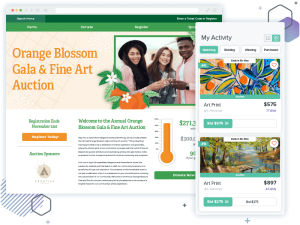Peer-to-peer fundraising empowers your donors with fundraising tools and personalized fundraising pages to raise money on your behalf. Your organization can tap into supporters’ existing social networks to increase community awareness of your cause and expand your donor base.
Nearly 40% of Americans have given to a nonprofit because of a friend or family member’s request, making peer-to-peer fundraising a particularly potent form of revenue generation for nonprofits. This guide covers everything you need to know to get started with peer-to-peer fundraising, including:
- Peer-to-peer fundraising FAQs
- Benefits of peer-to-peer fundraising
- 9 steps to launch your peer-to-peer campaign
- Peer-to-peer fundraising best practices
- Peer-to-peer fundraising ideas and examples
- How Qgiv by Bloomerang can support your peer-to-peer campaigns
Peer-to-peer fundraising FAQs
Here are some common questions about peer-to-peer fundraising:
What is peer-to-peer fundraising?
Peer-to-peer fundraising is a type of online fundraising that equips and empowers your supporters to raise money on your nonprofit’s behalf. By creating their own personalized fundraising campaigns, participants appeal to their personal networks for donations.
There are different styles, but peer-to-peer fundraising can support individual fundraising, team fundraising, or a mix of both. Your nonprofit can use peer-to-peer campaigns to encourage participation in an event, get supporters involved with your mission, and raise more money!
What is the difference between peer-to-peer fundraising and crowdfunding?
Peer-to-peer fundraising and crowdfunding are similar types of online fundraising with a few key differences:

- Structure. While peer-to-peer campaigns are decentralized, with participants creating their own fundraising pages, a crowdfunding campaign is centralized on one fundraising page shared with a large audience.
- Number of people asking for donations. Peer-to-peer fundraising often involves many people asking for donations on behalf of a nonprofit, while crowdfunding involves one person or group asking as wide an audience as possible for donations.
- Typical donation amounts. Donation amounts in peer-to-peer campaigns can vary, and fundraisers often accept pledges. For crowdfunding campaigns, donation amounts are often smaller.
- Promotional tactics. Peer-to-peer participants use their individual fundraising pages to collect donations and spread awareness for your cause. On the other hand, crowdfunding campaigns typically rely on word of mouth and social sharing to reach a wide audience.
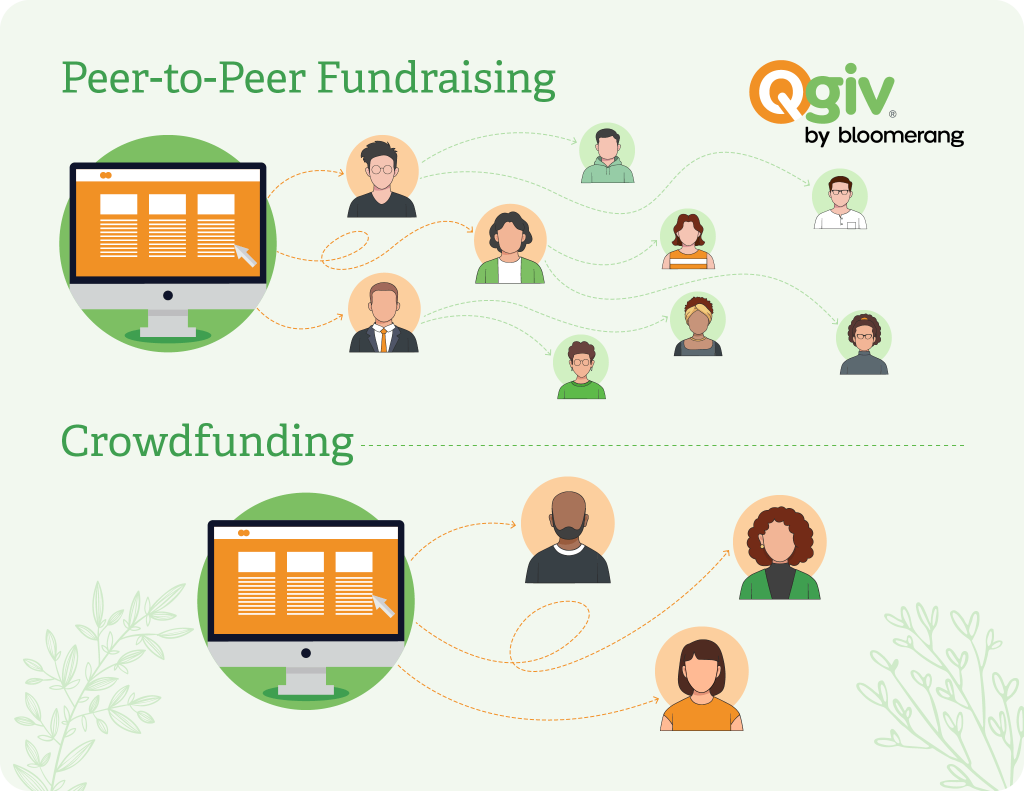
Both of these methods are handy ways of raising money for your organization! Take time to learn more about the differences between crowdfunding and peer-to-peer fundraising and figure out which method is right for you.
What are the different types of peer-to-peer fundraising campaigns?
There are many different types of peer-to-peer fundraising campaigns, making this a flexible strategy. Common types include:
- Virtual peer-to-peer campaigns. Participants raise money completely online, making fundraising simple.
- DIY fundraisers. Fundraisers take the initiative and host their own campaign to add a personal touch.
- A-thon events. Runs, walks, swims, dance-a-thons, and other a-thon events lend themselves well to peer-to-peer fundraising and can inspire competition among participants.
- Giving days. Build campaigns around universal giving days like GivingTuesday or cause-specific awareness days to boost support.
- Memorials. Fundraisers can create pages that help them raise funds to honor their loved ones.
What are the time parameters around peer-to-peer fundraising campaigns?
Your peer-to-peer fundraising campaigns can also take place on a time-based or rolling basis:
- Rolling campaigns can take place at any time. Supporters can start a campaign whenever they feel inspired to, without having to adhere to a specific deadline.
- Time-based campaigns have clear parameters, with a specific start and end date. These campaigns are often associated with events or giving days.
Benefits of peer-to-peer fundraising
Peer-to-peer fundraising can benefit your organization by helping you:
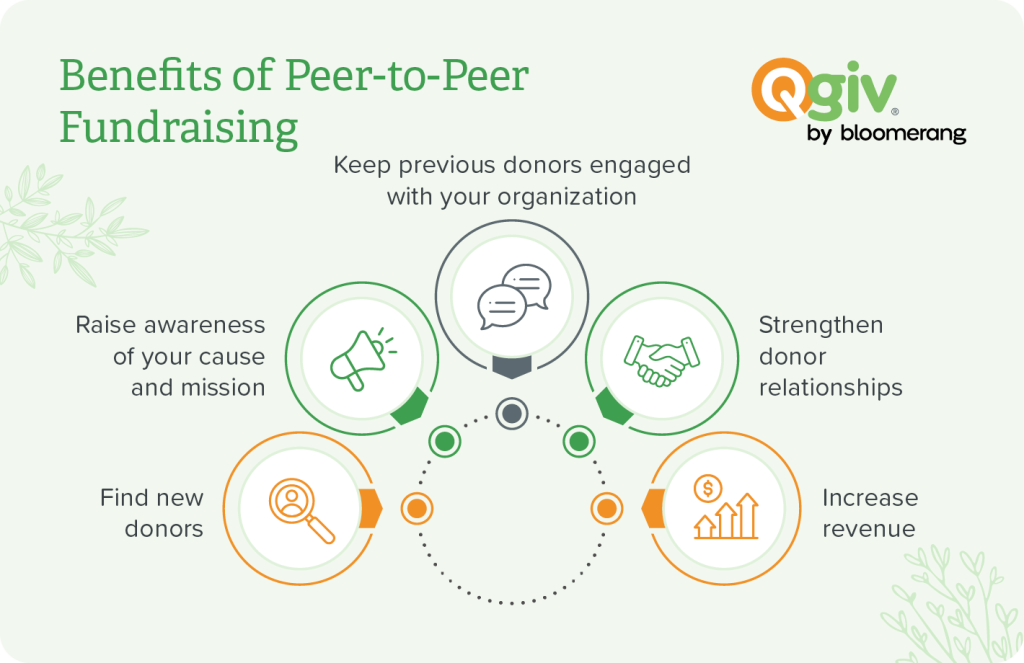
- Find new donors. According to data pulled from Qgiv’s platform, organizations recruit 300 new donors on average using peer-to-peer campaigns. They’re an easy, low-barrier way to get involved in your organization.
- Raise awareness of your cause and mission. 75% of peer-to-peer donors are first-time contributors. These campaigns help prospective supporters learn more about your cause and pique their interest.
- Keep previous donors engaged with your organization. Peer-to-peer fundraising provides supporters with a hands-on fundraising role. As a result, they can become more deeply involved with your organization and feel more connected to your mission.
- Strengthen donor relationships. When you entrust donors to raise money for your nonprofit, they essentially become part of your fundraising team. You’ll communicate with them more often and celebrate their wins, leading to stronger relationships.
- Increase revenue. Peer-to-peer fundraising helps you raise more for your cause by creating new bonds with prospective donors and building upon past relationships, especially when paired with existing campaigns or events.
9 steps to launch your peer-to-peer campaign
By now, you’re probably asking yourself, “How do I start my own campaign?” Let’s review the key steps involved in peer-to-peer fundraising.
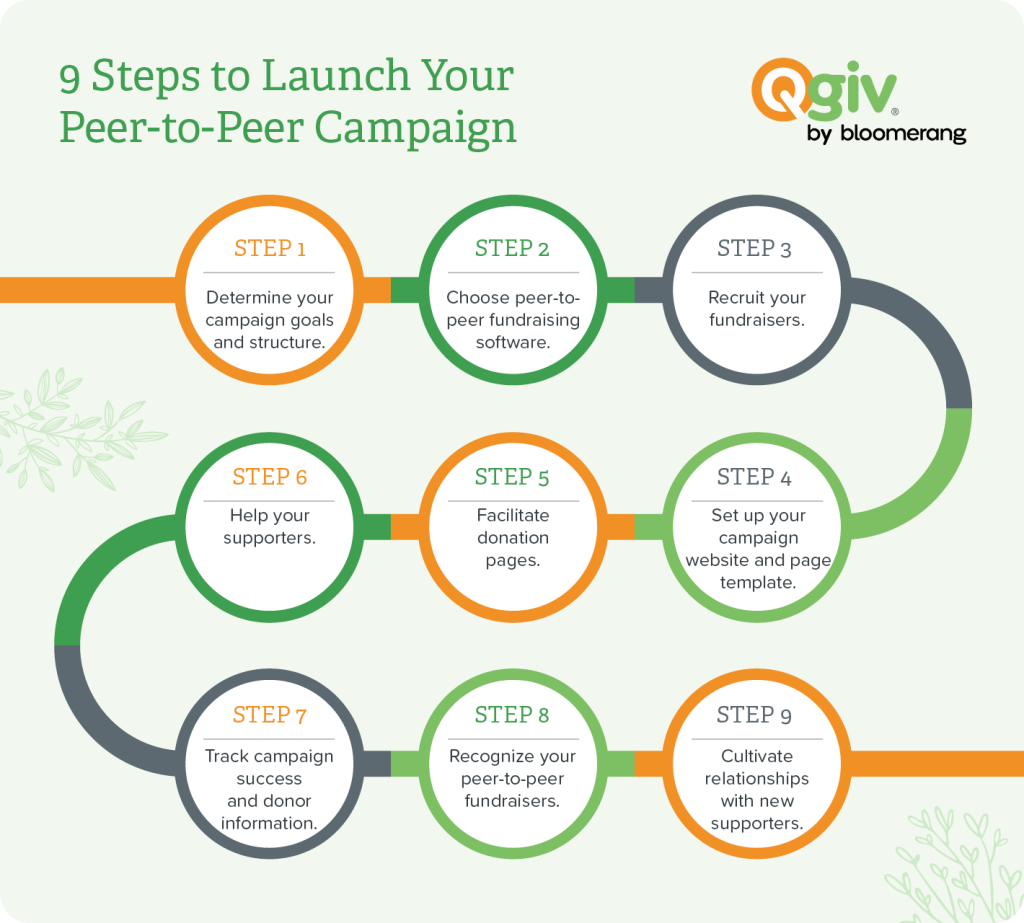
1. Define your campaign goals and structure.
Once you’ve decided to run a peer-to-peer fundraising campaign, ask yourself:
- What program or initiative are we raising money for?
- How much do we want to raise?
- Which kind of campaign is this—rolling or time-based?
- What’s the central theme?
Then, create a campaign checklist of relevant tasks. Setting your goals is a great way to keep everyone on the same page and ensure that you’re on the right track throughout your fundraiser.
2. Choose peer-to-peer fundraising software.
Comprehensive peer-to-peer fundraising software enables you to create fundraising pages, support both individual and team fundraising, track your campaign’s progress, and collect donor data.
Using a peer-to-peer fundraising platform to support your campaign can streamline your process by providing features such as:
- Customizable individual participant and team pages that empower fundraisers to maximize the funds they raise.
- Marketing tools like social sharing buttons and email tools that spread campaign and cause awareness.
- Online merchandise storefront to boost campaign revenue.
- Fundraising badges, thermometers, and fundraising leaderboards to gamify the fundraising experience and make it more engaging for participants.
- Custom data reporting to track campaign success.
When you’re shopping around for peer-to-peer software, look for a solution that is flexible and will grow with your organization’s needs and creativity. You should also find a platform that offers plenty of support and training options for your organization’s staff and leadership.
3. Recruit your fundraisers.
Once you’ve figured out your goals and secured your software, it’s time to reach out to your donors and volunteers to recruit participants for your peer-to-peer fundraiser. Here are some ways to start recruiting:
- Send out emails and post about your campaign on your social media accounts to grab people’s attention and get them excited to fundraise.
- If you’ve hosted peer-to-peer campaigns in the past, extend a special invitation to past participants to see if they’re willing to fundraise again.
- Offer incentives for people to become fundraisers, including free t-shirts and other prizes as well.
The sooner you start reaching out and spreading the word, the more participants you’ll be able to recruit!
4. Set up your campaign website and page template.
The bulk of your peer-to-peer campaign revolves around your campaign’s online presence. Your campaign page will be the template from which your participants will create their individual fundraising pages, while your campaign website will be the go-to resource for all of your participants, donors, volunteers, and anyone else involved in your fundraiser.
Here are a few tips and tricks to create an eye-catching, informative, and helpful campaign website and page for your next peer-to-peer campaign:
- Create an FAQ page. Anticipate common questions your fundraisers will have about peer-to-peer fundraising, the specifics of your campaign, or anything else they might be unsure about. Create an FAQ page to give your participants, donors, and volunteers a place to get answers.
- Use cohesive branding. Display your logo prominently on your website and stick to a visually appealing color scheme that reflects your organization’s branding or is specifically created for your campaign.
- Include a fundraising thermometer. Displaying your fundraising progress on your website helps people visualize how well your campaign is going. It also helps your donors feel proud about their contribution to your fundraiser’s success.
Choosing the right peer-to-peer fundraising software can help alleviate some of the stress of this step. A robust solution will offer customizable pages and tools, like fundraising thermometers, to help you and your supporters create compelling campaign pages.
5. Facilitate donation page creation.
Before your campaign starts, educate your fundraisers on how the campaign works, what your goals are, and how to use the fundraising software. To get them started on the right track, here are a few ways to help each participant design and personalize their own donation page:
- Give your participants writing prompts, talking points, and graphics they can use to create an engaging and effective fundraising page.
- After they’ve built their pages, instruct your fundraisers on how to share their donation pages and explain the campaign to friends and family.
- Provide them with access to social sharing buttons, post templates, and ways to sign up to be a volunteer or purchase merchandise.
6. Help your supporters.
Chances are, your peer-to-peer participants don’t have much experience with fundraising and asking for donations themselves. While they may have experience with being on the receiving end of a donation appeal, they probably don’t have any experience making that kind of request. Before you send your participants off to ask for donations, fully equip them to start fundraising.
Provide your fundraisers with email and social media templates, scripts, graphics, and storytelling tips and tricks so they can put their best foot forward when asking for donations. With these kinds of resources, all your participants need to do is fill in the blanks and send their well-crafted messages off to their family and friends.
7. Track campaign success and donor information.
As donations come in, you’ll need to keep track of your fundraisers’ efforts and collect new donor data by:
- Syncing new donor information to your CRM
- Updating your existing donor database records
- Linking donation and interaction history with your supporter profiles
Afterward, use that information to update your donors and participants about your progress. Running a peer-to-peer campaign will help you form deeper relationships with your donors and fundraisers, but you need to stay engaged with your supporters throughout the process!
8. Recognize your peer-to-peer fundraisers.
Once your campaign is over, you should recognize your participants for their work. Here are a few ways to show your appreciation:
- Thank your peer-to-peer fundraisers with a personal note, social post, email, and/or phone call.
- Use your end-of-campaign event to celebrate and recognize supporters.
- Let volunteer fundraisers know how much you appreciate their help and tell them what their fundraising has achieved.
- Follow up with your donors and fundraisers alike to share how you used the money they raised.
9. Cultivate relationships with new supporters.
Peer-to-peer campaigns expand your reach to new audiences. Donors who find your nonprofit through peer-to-peer campaigns can become valuable, long-term supporters if you make an effort to form strong relationships with them.
After thanking donors for their support, create a segment in your CRM for first-time supporters and send them a separate email fully introducing them to your organization. To keep them involved, provide additional engagement opportunities, like signing up for your newsletter, following your social media accounts, and registering for an upcoming event.
Peer-to-peer fundraising best practices
Wondering how you can step up your peer-to-peer game? Here are a few best practices all seasoned fundraisers keep in mind when running a peer-to-peer campaign.
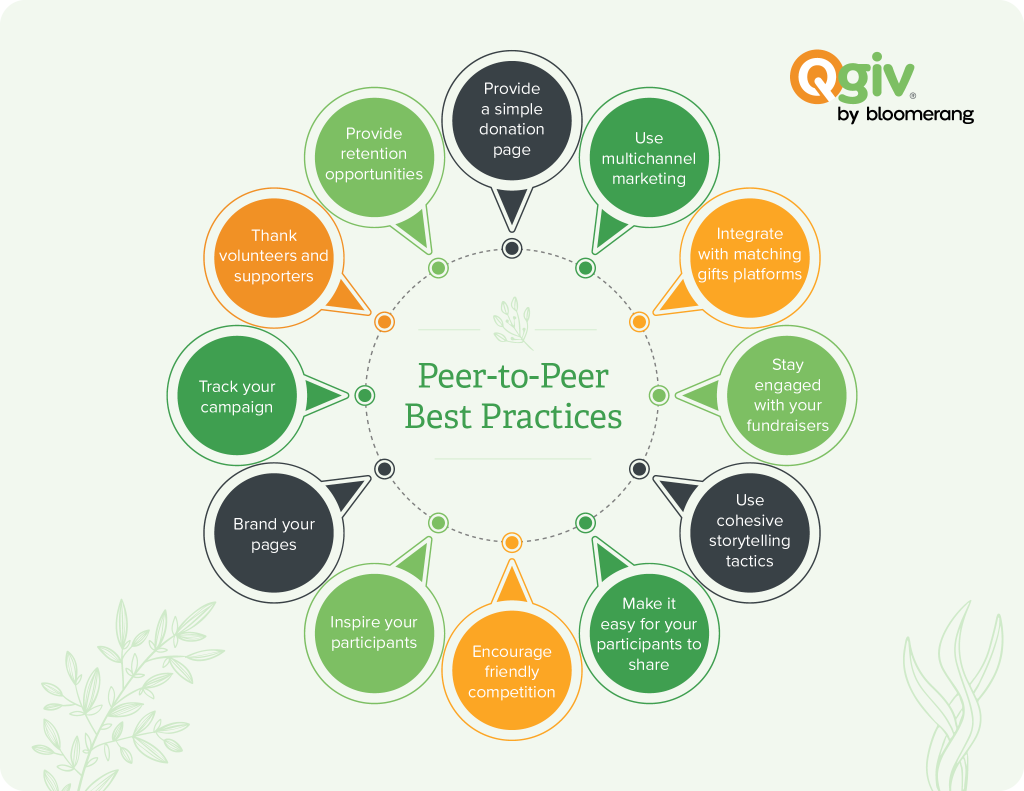
1. Provide a simple, fast donation page.
Donation pages can drastically affect your donor conversion rate. The way your forms are set up and how quickly they load can be the difference between a new donor and a lost opportunity.
According to M+R Benchmarks, the average nonprofit donation page load time is 2.33 seconds on desktop and 2.54 seconds on mobile. Research on e-commerce sites shows that the highest conversion rates occur between one and two seconds, with an average conversion rate of 3.05% at one second and 1.68% at two seconds.
Apply these insights by providing a simple and quick donation page for donors to fill out and complete as easily as possible, and use a tool like PageSpeed Insights to pinpoint where you can speed up load times.
2. Use multichannel marketing.
Once you’ve recruited your team of fundraisers and prepared them to raise money, how can you help them spread the message about your campaign?
Multichannel marketing can help you and your peer-to-peer participants reach more of your donors and even expand your reach beyond your usual network. Some effective ways to use multi-hannel marketing to spread the word about your peer-to-peer campaign and solicit donations include:
Email is one of the most impactful methods of asking for donations during this kind of fundraising campaign because it’s cost-effective and already incorporated into supporters’ everyday lives. It allows you to easily personalize communications and boost return on investment (ROI). Try providing your fundraisers with a few templates they can fill out and use to email friends and family about your campaign and their fundraising efforts.
Social Media
Facebook, X, Instagram, TikTok, and LinkedIn are all popular platforms your supporters are probably already using! By providing ready-made templates for different platforms, you make it easier for donors to create relevant, engaging posts. Sharing personal fundraising pages on social media brings them to the attention of your fundraisers’ friends and family.
Encourage your participants to post updates that share why they’re participating and ask people to give. Once they’ve started posting, interact with their posts by liking or commenting to drive engagement and make your participants feel heard.
Traditional Marketing
Direct mail, print advertisements, and face-to-face solicitations are great ways to engage donors who aren’t online or prefer more personal interactions.
Your participants can also solicit donations in person when they get together with their family and friends or by hanging up flyers in their communities. Provide your participants with scripts they can use to ask for donations when they’re fundraising face-to-face with others.
Text Messages
Text marketing can help you reach your supporters no matter where they are. Send campaign notifications and updates straight to their phones, along with a link to your donation form. Provide a keyword for supporters to text to donate to your fundraiser.
Blog
Maximize traffic to your campaign website by writing blog posts about your peer-to-peer fundraiser. Show examples of people you’ve been able to help using money raised from previous fundraisers.
Local Media
Reach out to local media outlets, such as news channels and radio stations, about sponsoring your peer-to-peer campaign. In exchange for their advertising your campaign, promote them on your fundraising page or event.
3. Integrate with matching gifts platforms.
Encourage your supporters to participate in their employers’ matching gift programs! Every donation made by an eligible donor can be matched at a 1:1, 2:1, or even 3:1 ratio. This means a single donation can have double the impact!
But how do you make it happen? Just provide your donors with access to a matching gift database like Double the Donation! Matching gifts databases allow donors to see if their gift is eligible for a match within your donation form. They can also review their employer’s matching gift requirements.
Add a matching gifts widget to your donation form so your donors don’t have to leave the page to check if their employer has a matching gift program. This widget also makes the matching gift process easier for their employers. Once your donor completes their gift, their donation information is automatically sent to their employer for processing.
Many companies have a minimum amount they will match. If your supporters know this, they may be inclined to make a larger donation. Imagine a donor was going to donate $15. Then, during the donation process, they learn their employer only matches gifts of $25 or higher. That donor will likely donate $25 so their gift can be matched, meaning you can receive $50!
4. Stay engaged with your fundraisers.
Once your fundraising campaign is in full swing, stay in contact with your fundraisers by:
- Sharing frequent campaign updates
- Acknowledging and celebrating the most successful fundraisers
- Encouraging hesitant participants
- Engaging with your fundraisers’ posts
Motivate your fundraisers and play to their strengths. Strengths may include a strong, engaged social media following or a close connection with locals in your community. Help them use those assets to raise money!
5. Use cohesive storytelling tactics.
As you send your participants out into the world to raise money for your organization, keep everyone on the same page about the campaign’s messaging. Ensure that all facts and figures you’ve shared with your participants are accurate and that your campaign’s tone is cohesive.
While it’s okay to tailor messages specifically to your audience and for your participants to do the same for their audiences, the main points of your campaign should be the same across every email and social media post you or your participants create and share. This consistency avoids confusion and instills confidence in your donors that they’re donating to the right cause.
6. Make it easy for your participants to share.
Once the fundraising gets started, your participants will frequently share their personal fundraising pages and information about your peer-to-peer campaign with their audience. To avoid forcing your participants to copy and paste the same information and links repeatedly, add social sharing buttons everywhere you can.
With a single click, your participants can share their personal fundraising pages, your campaign website, and any other important pages with their networks via email or social media. And with templates and scripts, crafting the perfect post shouldn’t take more than a couple of minutes. Use any tools you can think of to make sharing about your campaign easier for your participants.
The more they’re able to share your campaign, the wider within their networks you’ll reach. And with that wider reach comes more potential supporters for your cause.
7. Encourage friendly competition.
Motivating your participants is easy when you introduce a little friendly competition into your campaign! Offer prizes to the people who raise the most money by the end of your fundraiser, or reward them with badges every time they hit a fundraising milestone.
You can also allow participants to team up with their friends, family, or coworkers by creating fundraising teams. Fundraising with friends is always more fun, and setting out to conquer other teams as fundraising champions is an extra-engaging element you can add to your peer-to-peer fundraiser. Just make sure to add a team leaderboard to your campaign website so everyone can see where they stand and how much money they need to raise to reach the top spot!
8. Inspire your participants.
Do your fundraisers need an extra push or motivation to keep fundraising? Prizes are a great way to incentivize your participants, but there are plenty of other ways to keep them engaged and inspired.
Use your organization’s social media platforms to give them a little morale boost. Have any of your fundraisers shared a particularly moving reason for why they support your organization? Has anyone gotten creative with their fundraising efforts? Share about your participants and how they’re fundraising on your social media accounts.
You can also hold an awards show at the end of your campaign to publicly recognize your outstanding peer-to-peer fundraisers. Come up with creative awards and find ways to make all your participants feel proud of and appreciated for the work they put into fundraising.
9. Brand your pages.
Branding is how your supporters recognize your organization. Your donors know and trust your nonprofit with the money they give, so you want to make it as clear as possible who they’re donating to. Branding also keeps your fundraising pages cohesive for a more professional look.
10. Track your campaign.
Your fundraising software provides you with different metrics to track your campaign’s progress. By tracking your progress, you can determine how successful your different peer-to-peer strategies have been. Use metrics like average donation amount, number of donations per referral channel, and donation page bounce rate.
11. Thank supporters.
Thank both your participants and donors for all the help they’ve provided to your organization. If your supporters feel properly appreciated, they are more likely to participate in future campaigns. Automate acknowledgments to any donors immediately following their gifts, and schedule thank-you messages to your participants to go out within 48 hours of the end of your campaign.
12. Provide additional engagement opportunities.
When updating your supporters, provide other chances for them to connect with your organization. These may include:
- Volunteer opportunities
- Upcoming events
- Newsletter sign-up
- Surveys
Don’t ask for another donation right away. Keep supporters involved through nonmonetary opportunities that involve them more deeply in your organization and show you care to build deeper relationships with them.
Peer-to-peer fundraising ideas and examples
When it comes to peer-to-peer fundraising ideas, the possibilities are endless! Some of our top recommendations include:
- Walkathons and other fitness challenges like 5Ks
- Scavenger hunts
- Social media challenges
- Matching gift drives
- Holiday parties
The right peer-to-peer fundraising idea will depend on factors such as your audience, the events you already have on your fundraising calendar, and the time of year. For more guidance and additional ideas, check out our peer-to-peer fundraising ideas guide.
Peer-to-peer fundraising examples
Explore real-life examples of how Qgiv customers have leveraged our peer-to-peer features to launch successful campaigns:
Lauren McCluskey Foundation
The Lauren McCluskey Foundation is dedicated to educating, advocating, and conducting research about improved responses to relationship violence and stalking. Instead of raising funds on GivingTuesday, this foundation raises funds annually on February 12th, its namesake’s birthday, to honor Lauren and spread awareness about relationship violence.
For Lauren’s 28th birthday in 2025, the foundation exceeded its fundraising goal, raising more than $20,000. It was the nonprofit’s first time using Qgiv by Bloomerang’s peer-to-peer fundraising feature, and they nearly tripled the number of donors who got involved.
As Executive Director Edwin Gianini explains, “The success of that peer-to-peer campaign was largely due to the platform’s personalized campaign pages that could integrate with Facebook and its ease of user experience.”
Feeding South Florida
Feeding South Florida aims to end hunger in the area by distributing food to those in need, advocating about hunger and poverty in the community, and leading innovative programming and education efforts.
This nonprofit used several different platforms before switching to Qgiv, which increased their event efficiency and event fundraising by 60% within six months.
In AVP of Philanthropy Allyson Vaulx’s own words, “I love both the peer-to-peer and auction platforms. At my current and previous organizations, we’ve hosted 5Ks that are peer-to-peer driven. Qgiv makes peer-to-peer events incredibly easy internally and externally — tracking, using social media, teams, templates, and so much more.”
Carmel Swim Club
Carmel Swim Club uses Qgiv to support and grow its non-competitive community-based programs. Director of Business Development Maggie Mestrich had used Qgiv for seven years at a previous organization and was eager to get Carmel Swim Club up and running with the platform when she started her role.
In May 2021, the organization hosted an event called “10 Days of Courage, Perseverance, and Giving” that encompassed individual donations, merchandise sales, an auction, and peer-to-peer fundraising. With the help of Qgiv, Carmel Swim Club raised over $128,000.
As a long-time Qgiv user, Maggie has seen how the platform has evolved and appreciates the Qgiv team’s willingness to listen to and implement customer feedback. She particularly loves the suite of communication tools within the peer-to-peer platform, explaining that “The ability for our fundraising participants to reach out directly to their own networks when logged into their pages is a huge benefit.”
How Qgiv by Bloomerang can support your peer-to-peer campaigns
Strong peer-to-peer fundraising software makes it easy to build a great event page, launch your campaign, and support your participants as they raise money for your cause. With a suite of comprehensive fundraising tools and features, Qgiv by Bloomerang will support you the whole way, from the planning period to the final thank-you emails.
Qgiv offers a variety of features to take your peer-to-peer fundraising campaigns to the next level, including:
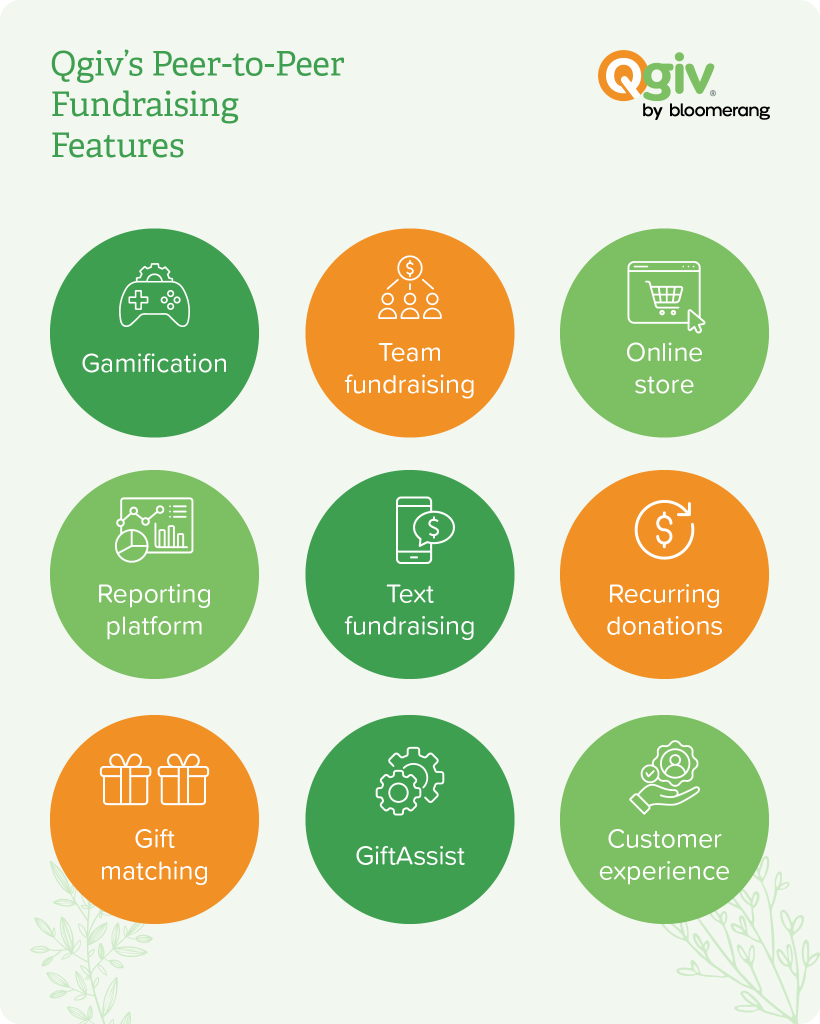
- Gamification: Competitive elements can help better motivate your peer-to-peer fundraisers to hit fundraising milestones for badges and raise more to get on your peer-to-peer leaderboard.
- Team fundraising: Make your peer-to-peer campaign a collaborative effort by allowing groups to raise money on a team! Teams allow people to work together towards a singular goal, making fundraising feel more achievable.
- Online store: Add an online store to your fundraiser for your participants and donors to buy merchandise. This can help you raise more funds and spread brand awareness.
- Reporting platform: Using the data you receive from donations can help you raise more in the future. With reporting tools, you’ll know what parts of your campaign worked and what didn’t, so you can make data-backed decisions for future fundraisers.
- Text fundraising: Pairing your peer-to-peer campaign with text fundraising helps your organization reach your participants on the devices they always have with them—their phones. With keywords and automated donation completion reminders, it’s easy for your donors to give on their phones, no matter where they are in the world.
- Recurring donations: Allow your peer-to-peer donors to make their donation recurring to encourage a long-term relationship with your organization. Automating recurring donations makes giving to your organization as easy as possible for your donors.
- Gift matching: Provide gift matching opportunities to your donors by allowing them to search for their employer on a gift matching database embedded directly onto your donation form.
- GiftAssist: GiftAssist allows your donors to offset processing costs for their gifts by adding a small amount to their donation. Your donors can add the additional amount right from your donation form as they complete their transaction.
Plus, when you partner with Qgiv for a peer-to-peer fundraising campaign, you’re not just getting our software. You can also unlock ongoing support throughout your campaign for troubleshooting, questions, and more.
Final thoughts
Peer-to-peer fundraising is a great way to spread awareness for your mission and further increase your fundraising efforts. You can reach new audiences through your current donors and volunteers in a more personal way. Use fundraising software to make your peer-to-peer campaign easier for both your team and your supporters.
Additional resources
Peer-to-peer fundraising is a great way to spread awareness for your mission and further increase your fundraising efforts. It allows you to reach new audiences through your current donors and volunteers in a more personal way. Use fundraising software to make your peer-to-peer campaign easier for both your team and your supporters.
- 30+ Engaging Peer-to-Peer Fundraising Ideas for Nonprofits. Want to host a peer-to-peer campaign? Check out this list of 30+ fun ideas to get started.
- How to Build a Major Gifts Pipeline Using Peer-to-Peer Fundraising. Explore how to incorporate major donors into the peer-to-peer fundraising process.
- 15 Top-Rated Nonprofit Peer-to-Peer Fundraising Platforms. Check out these 15 peer-to-peer fundraising platforms to find the right tools for your organization.




